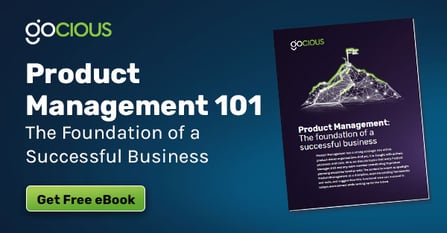Product Management has a strong strategic role within product-driven organizations.And yet, it is fraught with archaic processes and tools. Here, we discuss topics that every Product Manager, CEO and any team member contributing to product planning should be familiar with. The content is meant to spotlight Product Management as a discipline, examine existing frameworks and tools, and suggest how this functional area can succeed in today’s environment while setting up for the future.
The role of Product Management inside the organization
The world around us is changing rapidly. Technological advancements and consumer as well as B2B client expectations for all things “newer-better-faster” are putting pressure on businesses in all industries to adapt. Companies who are slow to fall in line with consumer and business expectations run the risk of falling behind, losing out to competitors, or worse.
Product Management plays a key role inside companies driven by their products; it’s instrumental for organizational growth and strategic market advantages.

A company’s Chief Officer will often have company growth strategies in mind that funnel directly to the Product Management function. The expectation for this function is to drive innovation inside the company and, most often, the more immediate market the company operates in. The Product Management team is expected to follow through with opportunities within current markets, expand into new markets, reach new audiences with existing products, as well as come up with incremental improvements to products and—most importantly for longer-term, sustainable growth—create brand new products that provide competitive advantage...or even introduce new product categories into the world. Enter 3-D printing, voice-activated assistants (hey, Siri), and the trusty iPhone.
While Product Management is arguably the most strategic arm of an organization, it often does not have a seat at the C-Suite table (more on this later).
The 5 steps of Product Management
It’s not a misnomer to say Product Management is the nucleus of a product-driven company. Internally, it connects to the development team on one side, and to marketing, sales and customer success teams on the other, all while ensuring outcomes are aligned with the company’s overall vision. Externally, Product Management deep-dives into the customer and market forces, to ensure demand and product/market fit. This five-step process ensures that the product specifications are correct, viable, and shared with different functional areas to serve as the catalyst for them to do their jobs.
There are five distinct stages that most Product Management teams must follow.
Step 1: Opportunity Identification
This step involves looking at the customer and the market. Product Managers collaborate with team team members tied to innovation, such as VP of Innovation or VP of Strategy. It’s a team effort to figure out what the existing or new target customer may want in order to stay or convert, with, ideally, the Product Manager at the helm. They would do a market assessment from different angles, and deploy a multitude of tools and strategies. The goal here is to define fundamental customer needs and initial product requirements that would feed into the opportunity.
Customer Knowledge
 This can mean using a wide variety of assessments and insights. For instance, customer engagement studies. These can be done internally, through hiring a 3rd-party firm or consultant to conduct research with your own customers or lookalike customer segments, purchasing an existing industry report (e.g. from Forrester or Gartner), or conducting your own grass-roots research through channels such as social media, email, websites, and community forums—and of course speaking with your own internal customer-facing functional areas such as Sales and Customer Support. As well as Marketing, who should have customer insights of their own, e.g. from Customer Relationship Management (CRM) tools, and organic and paid campaign reporting.
This can mean using a wide variety of assessments and insights. For instance, customer engagement studies. These can be done internally, through hiring a 3rd-party firm or consultant to conduct research with your own customers or lookalike customer segments, purchasing an existing industry report (e.g. from Forrester or Gartner), or conducting your own grass-roots research through channels such as social media, email, websites, and community forums—and of course speaking with your own internal customer-facing functional areas such as Sales and Customer Support. As well as Marketing, who should have customer insights of their own, e.g. from Customer Relationship Management (CRM) tools, and organic and paid campaign reporting.
Here is also where you would typically look at your current customer experience (UEx) and what can be improved to serve the customer better and increase satisfaction with your product. Really knowing the customer, and the customer voice involves understanding some of the metrics that matter to your organization. A few examples:
- Personas, consisting of fictional characters or profiles, which you create based on your research to represent the different customer types that might use your product in a similar way. You would use personas to create market segmentation, or subsets of a market based on demographics, needs, priorities, common interests, and other psychographic or behavioral data used to better understand your target customer.
- Customer Lifetime Value (LTV), which calculates what a customer is worth to your organization over their stay with you. A typical way to calculate it is the average order total X the average number of purchases in a year X average retention time in years.
- Economic Value to Customer (EVC), which is based on the insight that a customer will buy a product only if its value to them outweighs the value of the closest alternative.
- Value maps, which are visual tools that allow you to plan better. One type of value map, for example, allows you to study your product’s position in the market in a two-dimensional graph. “The best Value Maps are customer-centric, basing value scores on benefits instead of product features or performance.”1 Value maps can help Product Management and Marketing derive value scores based on more objective assessment in terms of what products deliver to customers.
Market Knowledge
 Understanding the space your company and products play in could mean many things, depending on your business type, size, and stage. No matter the particulars, you’re more than likely going to be doing some core market analysis that would include these exercises:
Understanding the space your company and products play in could mean many things, depending on your business type, size, and stage. No matter the particulars, you’re more than likely going to be doing some core market analysis that would include these exercises:
- Product/market fit, which, according to Marc Andreessen of Andreessen Horowitz means “being in a good market with a product that can satisfy that market.”2 Which essentially means that you need a good understanding of how big the market for your product is, what problem exists in that market, and most importantly, whether your product solves that problem sufficiently enough where a customer will be willing to pay for it.
- Competitive analysis, which maps to insights derived from gathering research from diverse sources, such as specialty software, industry reports, social media, websites, and business intelligence. The competitive research “...should include your competitors' features, market share, pricing, marketing, differentiators, strengths, weaknesses, geography, culture and customer reviews.”3
- Price analysis, which can make or break the success of your product. This is especially true if your product is somewhat commoditized, meaning, you don’t have a strong brand that can weather pricing missteps due to your loyal following (think Apple, Nike, Tesla) and you have lots of competition without significant product differentiation. Price analysis involves setting the right price for your product’s lifecycle that the market will withstand, while remaining profitable for your organization.
Step 2: Viability and Planning
 This step is about the initial product plan that takes you down the product definition process in order to end up with the product definition itself. You will use every insight gathered about the target customer and map your product to Jobs-to-be-done (JTBD). This method, coined by Clayton Christensen, follows the idea that customers use a product to accomplish a specific “job” or achieve a particular outcome (also see Outcome-Driven Innovation4).
This step is about the initial product plan that takes you down the product definition process in order to end up with the product definition itself. You will use every insight gathered about the target customer and map your product to Jobs-to-be-done (JTBD). This method, coined by Clayton Christensen, follows the idea that customers use a product to accomplish a specific “job” or achieve a particular outcome (also see Outcome-Driven Innovation4).
The set of “jobs” for the product amounts to a comprehensive list of the customer’s fundamental needs; the needs are translated into a set of product development requirements; and the requirements are mapped to product features and options. Here is also where the team reviews the different options and opportunities presented and makes decisions on what product(s) will be developed. On top of the market and customer-centric analyses, they look at other direct outcomes for their organization, such as revenue, margin, effect on brand perception, adoption, and similar factors. All the research, analytics, and inter-departmental collaboration culminates in a product plan that effectively becomes “the bible” for the entire product management process. All the functional teams that have a stake in product planning, management, production and promotion follow the product plan.
Step 3: Product Development
 This step is where the validation of the solution happens. Validation can come from internal sources, such as Finance, Engineering, etc., or external, such as focus groups. Essentially, the goal is to find out if there’s an actual opportunity to deliver the product. It’s also when you start to lock down the product requirements; the product definition gets more refined. At this stage, it’s important for the team to know when products will be released as well as the state of development.
This step is where the validation of the solution happens. Validation can come from internal sources, such as Finance, Engineering, etc., or external, such as focus groups. Essentially, the goal is to find out if there’s an actual opportunity to deliver the product. It’s also when you start to lock down the product requirements; the product definition gets more refined. At this stage, it’s important for the team to know when products will be released as well as the state of development.
While the Product Manager is not the Project Manager (see the “Product Management vs. Project Management'' section below), they have a key stake on WHEN the product or features will be out in the market. The delivery timeline depends on many factors, but here are two major considerations:
- Complexity of your product (think laptops, with few available features and configurations vs. cars, with a massive number of features and configurations)
- The degree of change you're embarking on. E.g. incremental product improvements vs. launching a brand new product, or even creating a category.
Step 4: Product Introduction
 This stage includes all the activities necessary to get ready for launch, and the launch itself. Although the Product Introduction step is a team effort, Product Management is the driver and key contributor.
This stage includes all the activities necessary to get ready for launch, and the launch itself. Although the Product Introduction step is a team effort, Product Management is the driver and key contributor.
Many factors go into consideration, such as local assortment planning for what will be sold in what markets and regulatory approvals for the geographical areas the product will be available; local markets would have already had input to ensure compliance.
Production planning for whether the production line can handle the proposed volume also happens here. And, importantly, so does all the team training for functional areas affected by the launch. For instance, workers on the line will need to be trained on handling any special requirements; Sales will need marketing materials and a rundown on special features, benefits and differentiation. The Product Manager will supply the key information to help the other teams make informed decisions and perform in their roles.
All this action culminates in the product launch.
Step 5: Ongoing Management
 The importance of this step cannot be underestimated. It’s easy to launch a product and then move on to other projects, as frequently happens for the busy and often under-resourced product teams. Though the post-launch activity can be some of the most crucial and insightful for the just-launched product, as well as informing the future product roadmap.
The importance of this step cannot be underestimated. It’s easy to launch a product and then move on to other projects, as frequently happens for the busy and often under-resourced product teams. Though the post-launch activity can be some of the most crucial and insightful for the just-launched product, as well as informing the future product roadmap.
Measuring the new product’s performance, capturing customer feedback, watching for any competitive moves in response to your product launch, and continuing promotion all fall into this bucket. Keeping a close eye on customer feedback and the market could naturally lead you back to steps 1 through 4, with the process yielding a brand new product; being consistent and high-touch with your post-launch analysis can and does help uncover new opportunities. As well as show impact from the new product, help make product improvements, and make end of lifecycle decisions.
The life of a Product Manager
On the surface, it’s pretty simple. A Product Manager is often called the “CEO of Product,” implying full governance over the birth, life, and death of their company’s produced goods. But that is not necessarily the case.
Many organizations will face either an absence of Product Management leadership at the executive level or a fierce power struggle for who should really be deciding what the company will develop next. Engineering, Industrial Design, Sales, Marketing and even Manufacturing will all have strong opinions about what the company should develop, while none of these groups can claim to be the true expert in knowing what customers really want; it’s not their primary role.
However, it absolutely is one of the focal responsibilities of the Product Manager. Given that this is a strategic role central to a company’s survival and growth, the Product Manager is in close contact with the customer and the market.
Product Manager vs. Product Line Manager vs. Product Portfolio Manager
Terminology can vary, depending on industry but especially company size. Inside large enterprises, there are likely teams of each title and even additional related roles. A Product Manager is often used interchangeably with Product Line Manager, particularly inside smaller companies. However, product line management is job of overseeing multiple product lines that are related to one another, while a Product Manager may manage one or more products that are or are not related.
And there are important differences between a Product Manager and a Product Portfolio Manager. “Product managers define the strategy and build the roadmap for a single product. Product portfolio managers oversee a group of product managers who are each responsible for a product. These folks set the strategic direction for the product portfolio as a whole—ensuring that collectively, the products contribute to moving broader organizational objectives forward.”5 Product Portfolio Managers are also responsible for expansion into new/adjacent markets. It stands to reason, then, that a product line broad and complex enough inside a large organization would warrant the Product Portfolio Manager role—and even have multiple managers responsible for a single product; at smaller companies, the roles may be held by a single person, or the Product Portfolio Manager role may not exist at all.
Product Management vs. Project Management
Keying “product management” into resources such as Lexico, powered by the Oxford Dictionary, gets you redirected to “project management”—a fact we found rather shocking. No wonder organizations across the US are thoroughly confused about the difference, and structure their organizations accordingly.
Rather than allowing Product Management to lead strategic planning, gathering customer feedback and competitive intelligence, all to advance innovation, they spend a lot of time breaking down tasks to get an understanding of costs; making sure the product is delivered on time; even allocating or requesting resources...AKA project management. In fact, 73% of a Product Manager's time is spent on tactical vs. strategic activities.6 On the surface, that may seem OK. After all, the project is moving forward, right? However, without clear delineations within the two disciplines—or at the very least, a clear priority list for an individual, with a bias towards strategy—the Product Manager isn’t spending enough time focused on customer wants and needs, funneling them into new, potentially profitable opportunities.
What Product Managers care about
 There are many factors professionals in these roles strive for on a daily basis, all of which show commitment to advancing the company’s vision and serving customers. The companies we work with as clients and our internal team, who come from varied and prominent product-driven companies (e.g., Microsoft, Ford Motor Company, Harley-Davidson, Norma Group, KPMG Consulting) have validated these priorities:
There are many factors professionals in these roles strive for on a daily basis, all of which show commitment to advancing the company’s vision and serving customers. The companies we work with as clients and our internal team, who come from varied and prominent product-driven companies (e.g., Microsoft, Ford Motor Company, Harley-Davidson, Norma Group, KPMG Consulting) have validated these priorities:
- Meeting or exceeding customer expectations
- Innovation that makes an impact
- Differentiated product
- Speed to market
- Setting the right strategy for growth
- Planning for the future
- Customer experience and retention
- Managing their existing product line(s).
Stakeholders and collaborators
While managing and defining products is not their primary role, these functional areas are instrumental to a successful development, launch and follow-through on opportunities.
Executives
They care most about overall company growth, fostering innovation inside their organization, and gaining market share. The executive team, especially the CEO, typically provides the vision and direction for the overall company, which means they also provide the highest level of leadership for products inside product-driven companies/manufacturers.
Engineering
The engineering team provides important input on product direction from a technical perspective; they make sure data is captured and represented correctly, and lend a critical voice around feasibility of putting a certain product into market. L
Marketing
Considering this team is responsible for ensuring product visibility in a likely noisy marketplace, they need to really understand the new product capabilities to craft the right story. Marking an impact in the market and driving sales or leads necessitates working closely inside the product management process.
Marketing is not only responsible for the storytelling and positioning the product correctly to customers, but also, together with the Product Manager, helps drive customer experience and retention. Much like Product Management, Marketing takes a more holistic view. The “4 Ps” are often at play: Product, Price, Place, Promotion. Because Marketing also has understanding of the market, the customer needs and opportunities, they can weigh in on pricing. While Product Management still owns the crucial “product” P.
Production
The main goal for the production team is to ensure that output is up to or exceeds standard. They’re responsible for meeting quantity and quality goals, and as such, like to have a seat at the product management table—to put reality checks into production goal-setting, and bring up any issues other functional areas may not be aware of.
Sales/Customer Support
The sales & support teams are the company’s “eyes and ears” on the ground. As such, they capture and communicate customer feedback and issues to be fixed. But they can also give the customer’s perspective on the new product and help capture demand, e.g. new feature introduction. It’s important to keep solid lines of communication between the Product and Sales functions.
Environmental factors affecting product-driven companies
Industry 4.0, or the Fourth Industrial Revolution7, is changing the way manufacturers plan and produce products. A major motivation is to produce products in the most efficient and effective way possible.
The Internet of Things
Increasingly, product roadmap management software is playing an important role in products that have previously been hardware-only, such as refrigerators, or had nothing to do with technology, such as clothing. In fact, the global Internet of Things (IoT) market is expected to reach a value of USD 1.4 Trillion by 2026, up from USD 761 Billion in 2020 during the forecast period (2021-2026)8. More and more products now have chips in them that contain software or connect to software. Commonplace devices gather vast amounts of data, much of which can and should be used to make better decisions about future products a manufacturer will be investing in. Usage data and how the users interact with the product is essential information for product teams to decide which features need enhancements, and which should be deprecated or replaced.
Technology as a catalyst for change
All the technological progress can also lead to manufacturers rethinking how they operate. For instance, you no longer have to wait five years for a product design to make it to market. Now, you can release a product with plans to make software updates (e.g., updating chips and firmware with new capabilities). This is true not only for products that are technical at their core (e.g., computing devices, such as laptops and cell phones) but also in a much wider swath of industries, such as industrial equipment, medical equipment, aerospace, automotive parts, as well as many consumer goods—from connected home devices like doorbells and thermostats to plush toys.
New customer expectations
Technological advancements bring with them changing customer expectations, whether business or consumer. “Succeeding in this new environment requires nimble, innovative and fast-moving businesses and factories.”9 The “usual way” of planning and manufacturing will no longer work in today’s competitive environment and with the modern customer. “Inflexible, traditional multiyear strategic plans are evolving into more agile plans, with a vision and roadmap designed to flex with changing market conditions. Built to maintain an ongoing competitive advantage, such approaches could use smart manufacturing to permeate the business, not just support the manufacturing operations.”10
The state of Product Management
Despite the changing world around us that includes meeting more demanding and complex customer expectations, and regardless of available technological advancements, investment in Product Management has not kept up. Why is that?
Legacy infrastructure; legacy thinking
The core goal for manufacturers used to be more simplistic; operations revolved around the production line, with a narrow focus on the number of widgets produced. As such, Product Management have been undervalued and under-resourced. Product Managers are overtaxed with product definitions, project management duties, and often end up executing on ideas that come from elsewhere (e.g., Engineering).
"Commonly, variability is recorded against the product content and is inextricably tied to the engineering definition of the product. That is, options and configurator constraints are defined using nodes in the Bill of Materials as the context for performing this work. This leaves little autonomy for the Product Managers—who are doing early product planning to reflect the voice of the customer and determining what features will be offered, and how the product suite will be broken down for the marketplace. Product Managers need the ability to formally consider different features to be offered, review, evaluate, whittle down, and finally decide what options should be offered to the market—all before engineering needs to get involved, and without the need to expose Product Management to the engineering definition of the product at all." 11
The best-case scenario would indeed play out this way. In practice, Product Managers are busy wearing multiple hats and fulfilling tasks, leaving little breathing room to be strategic and creative.
Lack of clarity
The confusion between Product Management and Project Management and what the two functional areas bring to the table has not been helpful. It has also been tough for companies to figure out exactly what’s needed to support product planning in today’s world (e.g., new tools), and then the further perception that investment in better tools and other resources has to be big to make a difference.
Lack of specialized tools
 Incredibly, with so many technological advancements and a near-universal move towards the cloud across industries, Product Management has been left behind. For instance, while project management has had cloud-based and collaboration-enabling tools such as Asana, Monday.com, Trello, and literally about a hundred others, product management has had...Excel.
Incredibly, with so many technological advancements and a near-universal move towards the cloud across industries, Product Management has been left behind. For instance, while project management has had cloud-based and collaboration-enabling tools such as Asana, Monday.com, Trello, and literally about a hundred others, product management has had...Excel.
Excel spreadsheets are still the most commonly used tool among Product Managers. We often hear that our clients need spreadsheets to manage their spreadsheets! And when it comes time to present information to the rest of the team? The go-to is another legacy tool ill-equipped to handle the complex demands of the product function: PowerPoint.
Let’s look at why this common Excel/PowerPoint combo is problematic.
Data is tough to manage
This is perhaps the biggest issue, requiring huge time investments on the part of the Product Manager.
- Data silos: keeping multiple spreadsheets contributes to closed information loops. There is no “single source of truth.” With lack of a central repository, it’s tough to sufficiently analyze existing data for optimal outcomes.
- Lack of flexibility: the data is “flat” and cannot be easily queried, or “sliced and diced.” Without this ability, it’s challenging to run comparative scenarios on, say, your feature sets or families. It’s highly inefficient to complete a simple task, such as seeing how a product configuration would be affected in price, desirability, etc. if a single variant was changed...nevermind multiple variants. It’s virtually impossible to manually do with Excel in an efficient manner.
- Unwieldy volumes: managing sometimes millions of data points is extremely challenging when done manually. It’s a huge time commitment that also takes the Product Manager away from more strategic activities and innovation. The Product Manager spends time making changes to variables/inputs and navigating interdependencies spreadsheet-to-spreadsheet; they need to update all the affected documents tied to a single change. And if there is more than one change, which there inevitably is, making all the adjustments across documents becomes a game of whack-a-mole.
Collaboration is challenging
 Excel is an inherently closed system. Changes made need to be shared as attachments and easily get lost once newer messages come in. PowerPoint is similar. Once the presentation is given in person, it’s often forgotten. With the lack of that “single source of truth” the team can refer and contribute to, it’s much harder to stay on top of information. A missed meeting or email can result in having to play catch-up or missing a crucial tidbit altogether, rather than being able to, say, log into a shared cloud-based tool and look up what’s needed in real-time.
Excel is an inherently closed system. Changes made need to be shared as attachments and easily get lost once newer messages come in. PowerPoint is similar. Once the presentation is given in person, it’s often forgotten. With the lack of that “single source of truth” the team can refer and contribute to, it’s much harder to stay on top of information. A missed meeting or email can result in having to play catch-up or missing a crucial tidbit altogether, rather than being able to, say, log into a shared cloud-based tool and look up what’s needed in real-time.
What should the process look like?
As more manufacturers are now shifting to a progressively strategic view for staying competitive in today’s market, product strategy is becoming increasingly important to a company’s growth and sustainability. In order to build a modern culture for major innovation, manufacturers can bring in an agile Product Portfolio Management function and distinguish it from Product Management. What’s the difference?
Product Portfolio Management vs. Product Management
Product Portfolio Management has the more global goal of overall strategic planning. This means oversight of an entire portfolio of products with a view of how to disrupt the portfolio itself. They understand the markets and naturally question the entire collection of products as it currently plays in these markets—with an eye on more radical changes. This function aims to predict competitive moves and looks at new markets together with opportunities to innovate new product lines and sunset deprecated products.
While Product Management focuses on product vision for a single product. The target is more on making incremental improvements, on a per-product basis. This function understands the market for one specific product and tracks competitive moves together with customer demand.
Requirements for an effective product portfolio strategy
 To foster a successful culture around product creation, companies need a strategic focus, which we’ve discussed a lot above. There needs to be an honest ability to look at what is being produced and gauge whether it’s still in line with market demand.
To foster a successful culture around product creation, companies need a strategic focus, which we’ve discussed a lot above. There needs to be an honest ability to look at what is being produced and gauge whether it’s still in line with market demand.
Another requirement is transparency. Product teams must be able to bring the wider organization together and have conversations around whether the company offerings are still a fit in the market and what changes might be needed and why. This could be a tougher proposition than it seems, as team members can become invested in the current lineup and how it ties back to their jobs, making them resistant to change.
Which is why unifying your team around product strategy is another tenet. Explaining to the other team members why changes need to be made, the benefits of evolving, and the detriment of not must be made clear to all. This will also be a great opportunity to invite input and strive for buy-in. Product Management can create a movement around making a change and start to assimilate change as the norm. The goal should be to paint the future and allow other team members to see their place in the new schema.
Agility and speed in responding to market changes is another non-negotiable. Being fast to respond to market changes is imperative to success today. There has to be an ability to assess the situation and quickly mobilize towards executing a new plan that fits better.
Continuous framework for continuous growth
Chances are, you already have a product portfolio management practice in place. So you need to ask yourself if your current process sets you up for getting into new and innovative products and making the right decisions for the outcomes you want. Effective product portfolio strategy and innovation requires the right pieces. And thus, The Three Ps...
Process
The Deming Cycle. Continuous improvement that loops planning-doing-verifying-acting. The circular process can look like this:
- Define and set up your current product portfolio
- Ideate new products to seize opportunities
- Plan and communicate out changes to your portfolio
- Track performance
- Identify opportunities to grow
Then loop back to #1.
People
To run and cultivate the process, you need an owner—a quarterback, shall we say. The Product Portfolio Manager is the natural choice for this role. Aside from owning the process, they will align the other players, and keep themselves and the others focused on business goals. The other team members include:
- General management
- Product marketing
- Sales
- Engineering and Project Management
- Finance
- Compliance
Platform
Product Portfolio Management must look beyond the Excel spreadsheet to a more comprehensive tool that is engineered for their unique needs. The right platform will be flexible and able to scale with the size of your operation. It will also give product teams the specific capabilities that address their day-to-day. It will streamline the tactical tasks typical Product Managers are steeped in while enabling and facilitating more of the strategic activities. In other words, it will connect strategy to tactics. And importantly, it will serve as “a single source of truth” for all stakeholders.
The platform would accommodate these activities:
- Planning
- Forecasting
- Looking at different variables and options/looking at specs that meet customer needs and satisfying the market
- Pricing
- Competitive analysis
- Market analysis/figuring out the right segmentation for your offerings.
The major platform components and what they should enable are:
- Key data: capture and maintain features of your own product and competitors’; historical sales performance; customer and market priorities.
- Technology: a single source for competitors and your product definition roadmap; ability to assess and analyze value and position products; collaborative space that is accessible from anywhere, anytime.
The tool needs to allow for flexibility and collaboration. Currently, more tools focus on one product at a time, and not the entire portfolio or collection of products. The next-generation platform must allow for wider capabilities. You should be able to manage groups of products, which means you can find common features and customer needs across product lines and categories of products to be reused. That leads to simplicity and faster time to market as you narrow down the product to what customers really need.
The path forward
 We, as a global culture, have seen modern visionaries at the helm of companies.12 We think of Steve Jobs, Elon Musk, Mark Zuckerberg, Bill Gates, all of whom led veritable empires. The issue is these kinds of radical innovators are rare. How can we foster more innovation, in general, and specifically, in product?
We, as a global culture, have seen modern visionaries at the helm of companies.12 We think of Steve Jobs, Elon Musk, Mark Zuckerberg, Bill Gates, all of whom led veritable empires. The issue is these kinds of radical innovators are rare. How can we foster more innovation, in general, and specifically, in product?
In truth, innovation doesn’t have to come from the top. People in the lower ranks of your company can bring forward radical and informed ideas that will open up companies to revolutions for how we do things today.
Empower more and more people inside the company to innovate. It will be about leveraging your specialists to come up with disruptive ideas. That will involve hiring the right people; giving them the tools and information; and creating the right culture, which would include giving your team breathing room, and providing the infrastructure or path to follow through.
Tooling and training Product Managers to truly be the CEOs of their product with accountability and ownership of their product line is essential to creating an innovative growth culture that keeps a company relevant and protects it from obsolescence.
Product Managers need product management tools in order to:
- Define and communicate the products and features to the rest of the organization efficiently. Either through increased transparency or by seamless data exchange between their systems and others such as CRM, PIM, PLM, and ERP.
- Capture the Voice of the Customer
- Analyze and understand the market, its segments, and customer profiles
- Have quantitative and qualitative tools and methods to determine the value of the product in the market
- Track the status of a product at a high level from conception to production and beyond, all in one place
Product Management is a hub connecting many aspects of an organization together around one mission: bringing value to customers and driving sustainable growth for the business.
Footnotes
- Using Value Maps: Insights that Guide Product Management & Marketing Strategy
- https://en.wikipedia.org/wiki/Product/market_fit
- https://www.businessnewsdaily.com/15737-business-competitor-analysis.html
- https://en.wikipedia.org/wiki/Outcome-Driven_Innovation
- The Product Manager vs. the Product Portfolio Manager | Aha!
- https://www.pragmaticinstitute.com/wp-content/uploads/2020/07/Pragmatic_Institute_Survey_2019_rev.pdf
- https://en.wikipedia.org/wiki/Fourth_Industrial_Revolution
- https://www.mordorintelligence.com/industry-reports/internet-of-things-moving-towards-a-smarter-tomorrow-market-industry
- https://www.forbes.com/sites/forbestechcouncil/2018/06/22/how-smart-manufacturing-strategies-help-meet-increasingly-complex-customer-expectations/?sh=6443ff7c2472
- https://www.forbes.com/sites/forbestechcouncil/2018/06/22/how-smart-manufacturing-strategies-help-meet-increasingly-complex-customer-expectations/?sh=6443ff7c2472
- https://blogs.sw.siemens.com/teamcenter/product-variant-management-delivering-the-variability-your-customers-demand/
- https://www.forbes.com/sites/stevedenning/2020/06/21/why-hardware-must-embrace-agile-principles/?sh=2f41575d75c8


